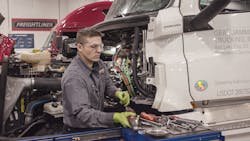Last August, Daimler Trucks North America (DTNA) launched its internal customer experience (CX) organization to ensure the market-leading truck maker was scoring high on the main indicator of any successful business: the satisfaction and return of existing customers. After more than a year in action, DTNA’s Chief CX Officer Paul Romanaggi virtually met with media to provide a recap of what he believed was a successful year of satisfying its large network of customers and dealers, along with how to build on that success.
So how did DTNA do?
The short summary is that technician numbers are back to pre-COVID-19 levels, parts sales are better year over year, and that truck sales in the fourth quarter are up as well. A lot of that has to do with tweaking workflows and responsibilities to get trucks in tech hands faster while working smarter, not harder.
The major focus was on uptime, as that’s directly related to keeping a customer happy and likely to come back.
“When the truck is up and running, generating revenue, it's making the customer at the end of that load happy because the products that they need to do their work to sell in their retail shop are arriving on time, the driver is happy and making money,” Romanaggi said.
DTNA felt there was room for improvement. CX found 80% of the problems were related to technician productivity capacity, pre-authorizing work not related to warranties, and parts availability.
To improve on these three areas, DTNA first launched a customer council comprising 16 fleet members. A program called Service Pre-Authorization, which sets a customized credit line by dealer, was also created through Pinnacle Fleet Solutions to bypass that wait time and immediately get the work started.
“The dealer can't simply bill that pre-authorized amount,” Romanaggi said. “After they do the work, they must present the work that they did, the price of the parts, and the amount of labor, and the fleet has to accept it.”
On only very rare occasions has the fleet questioned the work before accepting the invoice, he noted.
“Overall, the program has been a gigantic success,” Romanaggi said. “It has hugely eliminated the wait time for a technician to get started on the job.”
That has been monumentally important as the industry went into 2020 with a shortage of skilled technicians and the COVID-19 pandemic initially kept many at home, as well as slowed down work due to safe distancing and sanitizing the truck after repairs.
“There's no doubt about it—we lost productivity, and we lost capacity during the depths of COVID,” Romanaggi said. “And we're just now starting to see the return of the number of technicians we had pre-COVID coming back into the workforce now.”
DTNA already routinely invested “tens of millions of dollars” to improve commercial vehicle technician recruiting, training and retention every year, Romanaggi said, while fleets, dealers and other service centers spend much more. But they all fell short in one key metric.
“One thing we haven't done well as an industry over the years is looked at the opportunity for productivity of these scarce resources,” the 35-year DTNA veteran said.
There were several areas of inefficiency. These specially skilled techs would spend non-value add time walking to the parts counter, hiking through the parking lot to pull in the next truck and languish on hold with OEMs or supplier representatives to get the job preauthorized.
“With that scarce resource, you want all of those techs’ time focused on diagnostic, repair, validation — you don't want them doing all these other non-value added things,” Romanaggi said.
The fix was to simplify the workflow into a one-stop system and leverage a new feature to the Uptime Management Suite called Techlane. This uses big data analytics and pulls warranty history cross-referenced with faulty codes to speed up the diagnostics phase.
“Over 80% of the trucks that are coming in, now we can dump the fault codes, we can take the driver complaint, we can look at all the history of that vehicles repairs, we know all the components, the spec of the vehicle,” Romanaggi said. “We can tell the technicians through big data analytics, ‘Here's the problem with the truck. Don't spend any more time diagnosing or doing decision trees.’”
This essentially puts the onus of telling that serviced truck’s story on the data and leaving it up to a technician. When the tech does need to add input, a voice application app for smartphones, TechAssist, helps them do that quickly. It was inspired by dealer maintenance techs at the DTNA-sponsored 2019 Hackathon, who then created the company Reinforce Inc. to develop and deploy it.
Another way to speed up time was automating 75% of the warranty claim and/or customer invoice.
“Service Pre-Authorization and Techlane have brought a new level of efficiency to our service operations, dramatically improving our customer experience by reducing the amount of time their vehicles spend in our shops for repair,” said Scott Zeppenfeldt, senior vice president of Operations, Velocity Truck Centers, an early adopter of these programs.
Overall, DTNA uptime has improved to more than 60% truck turnaround in 24 hours and 40-45% for same-day rate turnaround time.
"These these initiatives are starting to take hold, Romanaggi said. "We are starting to see a tick up in our in our turnaround time."
The group’s initial goals were to optimize four specific areas, before forging ahead:
- Faster speed and effectiveness in solving customers’ most immediate needs
- Engaging in a “holistic approach” to providing the full benefit of DTNA offerings
- Maintaining insights into opportunities for continuous improvement; and
- Being proactive in understanding customers’ business needs for the future.
Romanaggi explained that the CX division also needed to implement an execution strategy around four core principles:
- CX measurement to understand how customers view company position and strengths and weaknesses
- CX improvement based on feedback
- Keeping a strong culture based on accountability across the company for improving CX: “Everybody needs to know they have a role and responsibility in meeting and exceeding and achieving all of the customers needs to build loyalty to build long term relationships,” Romanaggi said.
- Digitizing CX for real-time visibility and accessibility
About the Author
John Hitch
Editor
John Hitch is the editor-in-chief of Fleet Maintenance, providing maintenance management and technicians with the the latest information on the tools and strategies to keep their fleets' commercial vehicles moving. He is based out of Cleveland, Ohio, and was previously senior editor for FleetOwner. He previously wrote about manufacturing and advanced technology for IndustryWeek and New Equipment Digest.

